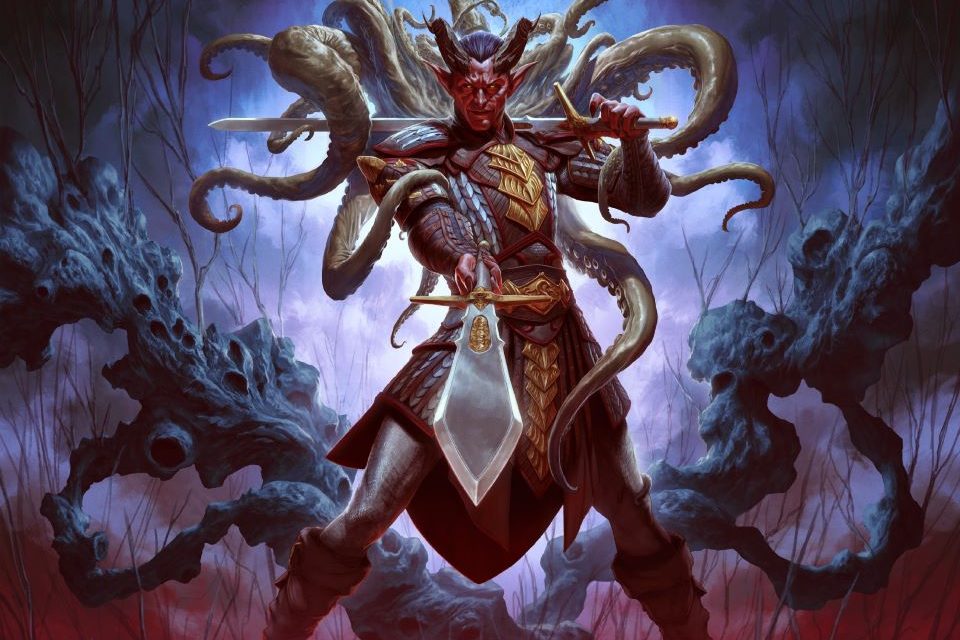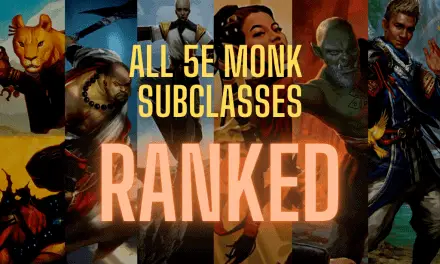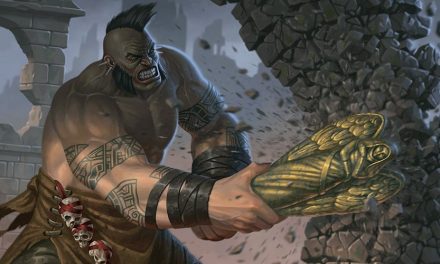Through force of will, chance, intense research into forbidden knowledge, or some combination of the three, you have made contact with a force beyond space, time, and mortal sanity.
Your desire for knowledge has led you to make a pact with a being known as a Great Old One.
Relish in the power that this being gives you, dear Warlock. After all, isn’t your sanity just a small price to pay for what your patron offers?
Find out in this guide to the Great Old One Warlock in D&D 5e!
What is the Great Old One Warlock in D&D 5e?
The Great Old One Patron is a being that exists far beyond that which mortals can comprehend. This is a Warlock Patron option found in the 5e Player’s Handbook.
Its origins, methods, and motives are a complete mystery. However, this Great Old One does have a seemingly infinite pool of knowledge that you have been able to pull from.
It’s possible that this Patron has knowingly made some kind of pact with you. In exchange for your service as a force to further its will, it can reveal the secrets of the universe to you.
More often than not, though, you are so small and insignificant in comparison to this being that it does not even take an interest in you. As you continue to pull power and knowledge from this being, your mind slowly twists and warps with a desire for more.
As your power grows and your mind begins to fracture, this Great Old One might finally notice you and see you worthy of a place in its plans. Oh what a happy day that will be for you!
In both theme and name, Great Old Ones pull heavily from the work of the writer H.P. Lovecraft. Cthulhu is a common patron for these Warlocks, but for those who would prefer something different (and with fewer tentacles), there are other options as well.
You might have made contact with a being like Hastur (The King in Yellow) or legendary Forgotten Realms beings like Tharizdun (The Chained God) or Dendar (the Night Serpent.)
Because of the sheer power of the being to which you have tethered yourself, it’s possible that you might not even know its name for quite some time. Only when your mind is sufficiently warped to their needs will you finally even learn the name of your Patron.
Related: The Ultimate Guide to Warlock Patrons in D&D 5e
Role in the Party
Warlocks who take the Great Old One Patron in D&D 5e focus primarily on information and utility within their party. There is also some enchantment magic within the abilities that you gain from your patron.
You are best when it comes to finding out information and manipulating others. As we’ll discuss in the next section, you’ll also gain some handy defensive abilities to keep you alive while you further your patron’s agenda.
With the Great Old One as your Patron, you’re pretty firmly a caster.
Your spells and abilities will let you root through enemies’ minds to uncover their secrets or dominate their thoughts entirely. You offer some very solid crowd control to your party as a result of these manipulations as well!
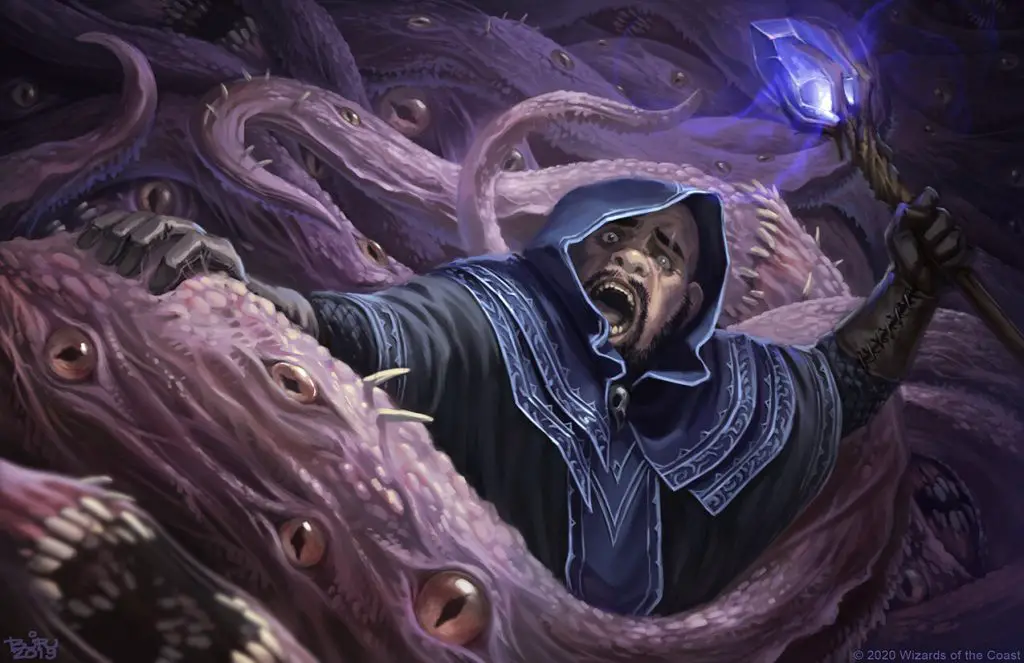
Great Old One Warlock 5e Features
Alright, so now that we have an idea of who your Patron is and your role in the party, let’s get to cover the Great Old One Warlock’s abilities!
Expanded Spell List (Level 1)
Choosing the Great Old One as your patron gets you an expanded spell list!
| Spell Level | Spells |
| 1 | Dissonant Whispers, Tasha’s Hideous Laughter |
| 2 | Detect Thoughts, Phantasmal Force |
| 3 | Clairvoyance, Sending |
| 4 | Dominate Beast, Evard’s Black Tentacles |
| 5 | Dominate Person, Telekinesis |
There’s a major focus on mental abilities here. Some are going to be a little more on the niche side of things, but you’ll be glad you have them when such situations arise!
Spells like Dissonant Whispers and Tasha’s Hideous Laughter can be great for crowd control and rendering enemies useless.
In time, you’ll be able to dominate beasts and enemy humanoids to bend their minds to your will.
For some utility, Detect Thoughts can be useful for rooting out others’ secrets while Sending is always a nice way to keep in contact with others as you need. The Clairvoyance spell is a powerful tool for gathering information if you are able to make room for the 10 minute casting time!
There’s a bit of damage sprinkled into this spell list with Evard’s Black Tentacles which is a solid AoE spell.
Depending on how you use them, Phantasmal Force and Telekinesis can have a ton of applications for utility, crowd control, and/or damage.
Awakened Mind (Level 1)
As madness takes its hold and your mind is awakened to the truths of the universe being revealed by your Patron, you find a new way of communicating with others.
Your alien knowledge gives you the ability to touch the minds of other creatures. You can telepathically speak to any creature you can see within 30 feet of you. You don’t need to share a language with the creature for it to understand your telepathic utterances, but the creature must be able to understand at least one language.
As long as a creature is intelligent enough to have any language, you can communicate with it. The uses here are virtually infinite. Not only are you a great communicator with most beings, but you’re also discreet!
Not to mention that the whole “speaking telepathically” thing can really add to the unsettling feeling that your character is likely going for having chosen the Great Old One as your patron.
Unless your DM is open to allowing this to be a two-way communication ability, keep in mind that it’s only a one-way conversation.
Also Check Out: The Complete Guide to the Warlock Class in D&D 5e!
Entropic Ward (Level 6)
Once per short or long rest, you can use your Entropic Ward to bend fortune to your favor.
When a creature makes an attack roll against you, you can use your reaction to impose disadvantage on that roll. If the attack misses, your next attack roll against the creature has advantage if you make it before the end of your next turn.
Honestly, this is a pretty cool defensive ability.
Using Entropic Ward to give an enemy disadvantage on their attack against you is great as it is, but the second part of the ability is where it gets really fun.
As a Warlock, cantrips like Eldritch Blast are your bread and butter in combat.
If your Entropic Ward caused the enemy’s attack to miss, you’re now rolling with advantage on your next attack roll. This means that your next Eldritch Blast, swing with your Pact Weapon, or whatever other attack roll has the potential to be devastating to the fool who just tried to smack you!
You might be a bit turned off by the fact that you only get this ability once per short or long rest. It seems like a pretty stiff limit, but remember that Warlocks get their spells back on a short rest. These short rests won’t be uncommon as you try to make full use of your few available spells.
So don’t worry too much about holding your Entropic Ward for that “perfect” moment. If an enemy tries to hit you and you expect you can reasonably follow up with some punishment, go for it!
Thought Shield (Level 10)
At level 10, you gain another defensive ability.
Thought Shield is interesting and effectively gives you three defensive bonuses. The downside is that the usefulness of this feature really depends on what kind of enemies you’re facing.
Your thoughts can’t be read by telepathy or other means unless you allow it.
You also have resistance to psychic damage, and whenever a creature deals psychic damage to you, that creature takes the same amount of damage that you do.
There are some spells and effects that can read your mind, but they aren’t particularly common.
If you’re storming the bad guy’s lair, they might be keeping eyes on you with something like a Scrying spell or whatnot. If you find yourself being interrogated and the enemy tries to use Detect Thoughts, this could come in handy, but that’s probably unlikely to happen.
The second part of this ability is that it gives you resistance to Psychic damage.
Psychic damage is one of the least-resisted damage types in the game, but it’s also one of the rarest. Mind Flayers and the like will have a much harder time with you, though, so your brain is probably pretty safe.
The last part of Thought Shield sees the enemy that just dealt psychic damage to you taking some damage themselves.
So you already take half damage from psychic attacks thanks to your resistance, and now you and the source of the attack are both taking whatever’s left of the damage.
Every little bit counts, I guess?
If your adventure sees you routinely squaring up against Mind Flayers or Gith, this ability will be more useful. In most adventures, though, it’s a bit on the “meh” side.
Create Thrall (Level 14)
We finally come to the capstone feature for the Great Old One Patron: Create Thrall.
Be honest, this is probably what you’ve been waiting for, right?
After all, much like brunch, falling into madness is best with friends!
You can use your action to touch an incapacitated humanoid. That creature is then charmed by you until a remove curse spell is cast on it, the charmed condition is removed from it, or you use this feature again.
You can communicate telepathically with the charmed creature as long as the two of you are on the same plane of existence.
Notice that there really aren’t many limitations to this feature. It doesn’t use up any resources and your target doesn’t get a save. As long as they’re incapacitated and you can touch them, their mind is now yours to control!
Fortunately, you’ve got plenty of ways to incapacitate enemies. Tasha’s Hideous Laughter is a solid option from your Expanded Spell List for this, but taking Hypnotic Pattern is a great way to get your pick of the litter, so to speak.
Without spells like Remove Curse or Dispel Magic being cast on your minions, this Charm effect can last forever if you don’t use it again.
Choosing a Thrall
Making a thrall out of an NPC that is in a position of power can quickly result in you having a very formidable ally.
Using this on the leader of a city could see you gaining the support of the entire town guard. Perhaps you manage to ensnare the mind of a high priest and have them begin turning their follower’s attention to worshipping your Patron. That ought to get you some brownie points!
Look for NPCs that will grant you the biggest return and open doors that otherwise might have been closed to you.
Don’t be afraid to upgrade your thrall as the story progresses, but it’s probably not a bad idea to have a plan for what to do with your old one. If you think they might be useful again later, you might be able to convince them to stay where you can find them again.
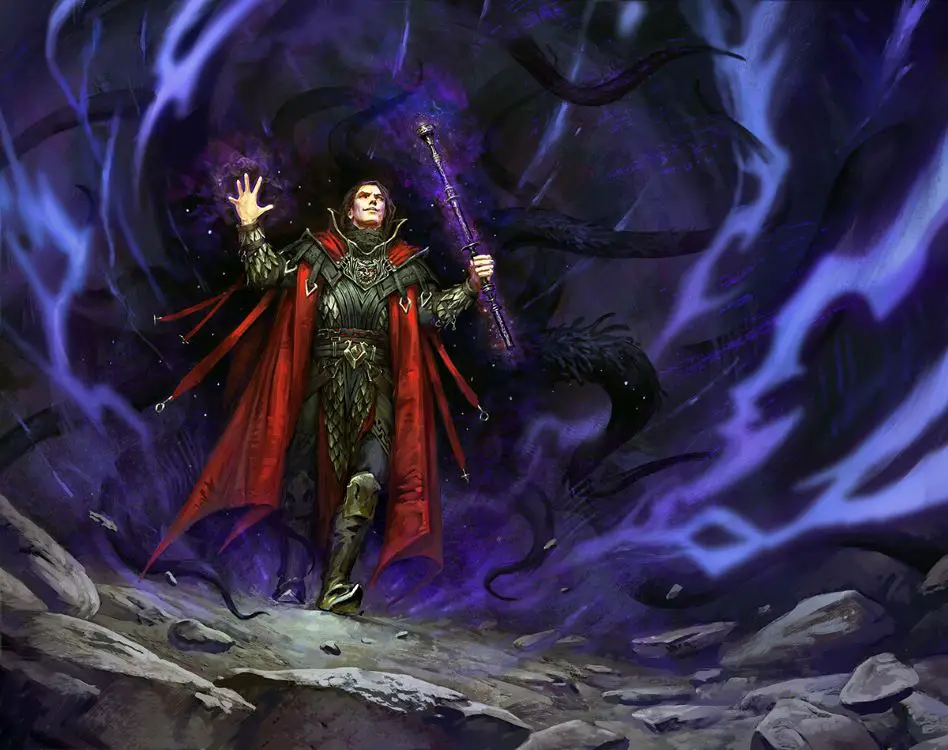
Pact Boons for Great Old One Warlocks 5e
As a Warlock, you have another choice to make relatively early on at level 3. The powers granted to you by the Great Old One also manifest as a Pact Boon.
This is where you really focus in on how your Warlock plays. The Pact Boon that you choose ultimately determines what kind of Eldritch Invocations you’re able to use and where your specialty really lies.
You can choose whichever of these you prefer. I’ll explain a bit more about how a Great Old One Warlock might look with each of the available Pact Boons and offer my two cents on which ones are the best options in most cases.
Related: The Full Guide to Warlock Pact Boons in D&D 5e
Pact of the Blade
I wouldn’t say that the Pact of the Blade is a useless option for a Great Old One Warlock, but it’s the weakest of your options.
You don’t gain any abilities from the Great Old One that will specifically help you pump out more melee damage. However, Entropic Ward can prove useful in a pinch.
All in all, though, there’s not a great deal of synergy here. Ideally, your Pact Boon really focuses in on whatever aspect of your Patron Features that you want to double down on in your role.
I could see a Great Old One Warlock who chooses the Pact of the Blade summoning a weapon that hints to the maddening and unsettling nature of the Patron. I imagine a sword with a large eye that’s constantly looking around or seems to be forged from some grotesque otherworldly material.
Pact of the Chain
The Pact of the Chain is pretty consistently towards the top of the list for most Warlock Patrons.
Having a familiar can really open up a great deal of utility for your character. Furthermore, because the Pact of the Chain opens up new familiar options for you, you can get even more use out of it than a familiar that would otherwise be available to any caster.
Since you traffic so highly in gathering information, having a familiar to do some recon work can be a great asset to your character. It also gives you a nifty way of delivering your touch spells with the added advantage from your Entropic Shield.
Realistically, any of the familiar options could make sense for a Great Old One Warlock. After all, nobody truly knows your Patron’s plans, machinations, and methods!
Your DM is probably cool with reskinning whatever familiar you choose to add a type of otherworldly look to it. Your imp may look like some kind of twisted gremlin with 9 eyes or your pseudodragon might have tentacles dripping with some kind of slime as a bizarre goatee.
Pact of the Talisman
The Pact of the Talisman is the newest Pact Boon from Tasha’s Cauldron of Everything. The abilities granted to you by this Pact greatly favor a type of general support.
The thing is, the Pact of the Talisman has its merits with any Warlock Patron. However, I think that there’s a pretty solid thematic consistency between this Pact Boon and the Great Old One Patron.
The abilities granted to you by the Pact of the Talisman allow the wearer (not necessarily you) to gain bonuses on their ability checks. You can further this by taking the Protection of the Talisman Invocation which allows the wearer to get a bonus to their saving throws as well.
But it’s the Rebuke of the Talisman Invocation that I like the most about this option.
You have your ally wear your Talisman so that anytime they’re hit by an attack and within 30 feet of you, you can use your reaction to deal psychic damage to the attacker and send them flying back 10 feet. It’s a good use of your reaction and gives you another unorthodox way of dealing damage.
I’m torn between the Pact of the Talisman and the Pact of the Tome if I had to choose my top pick for the best Pact Boon for a Great Old One Warlock. If nothing else, this is a very interesting option!
Pact of the Tome
With the Pact of the Tome, your Book of Shadows gets you more cantrips. As a Warlock, cantrips are your best friend and being able to gain three more from any class’s spell list is very useful.
If you take the Book of Ancient Secrets Invocation, you also benefit from collecting ritual spells to add to your dark arsenal.
This is a standout option for Great Old One Warlocks who are looking to double down on their spellcasting abilities.
As for how your Book of Shadows looks, it could be anything. Maybe it appears as a nondescript leather-bound book filled with what appears to be blank pages to those who do not understand your Patron’s calls. To your eyes, however, there are clear instructions for how to bring about your master’s will.
Maybe it’s a tattered tome filled with the mad scrawlings and seemingly nonsense of a previous servant (or servants) of your Patron.
You might even get a little silly with it and have it resemble a harmless children’s book. Beneath the fairy tales and cute pictures, however, you see the hidden messages left by your Patron.
As I mentioned, I’m torn between this and the Pact of the Talisman if I had to choose the best Pact Boon option for a GOO-lock!
Related: Eldritch Invocations for Warlocks (Explanation + Top Picks!)

Connections
There are plenty of ways to connect a Great Old One Warlock to the campaign’s story and the party.
Ask yourself a few key questions:
- What part of your character’s studies drew their interest towards the unspeakable Great Old Ones?
- Do they know that others have gone mad walking this path? Do they embrace that or do they feel that they are the exception?
- Is their Patron active in their life or is it distant and they are trying to gain its attention?
These Warlocks, perhaps more than most, crave knowledge and power. Perhaps they believe that joining the party will aid them on this quest.
Your character has a way of knowing things that makes them valuable to the party, but do they respect boundaries with their allies? Otherwise, do they have a habit of casually mentioning embarrassing truths of their party members?
A Warlock who serves the Great Old One is likely to be somewhat polarizing in the party. They dwell in such a gray area where the notions of good and evil don’t entirely apply (at least not in clearly defined ways!)
When examining your character’s connections to the party, promote the value that your character offers the party.
If you’re always just “the one doing crazy stuff” you might get viewed as more of a hindrance than a help. However, if your talents regularly assist the party they might be inclined to look past your… shall we say… eccentricities…
Is the Great Old One Warlock Good?
All in all, I’d say that the Great Old One is a good Warlock Patron option. It definitely stands out more in some types of campaigns than others, but mechanically there’s a lot here that isn’t necessarily present in other options.
In an intrigue campaign, you’re insanely powerful considering all of your mental abilities. But even outside of an intrigue campaign, you’ve got the mechanics to keep you relevant at pretty much every tier of play.
The biggest risk that I have seen with a Great Old One Warlock more comes down to the theming and how it’s played.
Kind of like I mentioned above, you don’t want to be a hindrance to the party. I’ve seen too many cases where a GOO-lock just has goals and methods so far detached from the party that it just makes playing the game difficult.
You should be weird, and at times your motives or methods should be incomprehensible. Just don’t overdo it.
If your group is playing a campaign that’s all about slaying dragons and taking their loot, expecting your DM to stitch in an entire Cthulhu arc can be asking a lot from everyone at the table.
The balance itself really depends on your group and DM, but don’t forget your table etiquette when roleplaying your character.
Try to take an active role in discussing your character’s goals with your DM. What is your Patron asking of you and how can you make that fit within the story being told?
How does the Great Old One compare to other Warlock patrons? Find out in my full ranking of every Warlock subclass in 5e!
Conclusion – Great Old One Warlock in D&D 5e
It’s astounding, isn’t it?
Time is fleeting and madness takes its toll…
The Great Old One is quite possibly the creepiest of all of the Warlock Patron options. There’s something especially terrifying about a force so large and so remote that it might not even register your very existence.
While other Patrons may have clear motivations and terms of their pact with a given Warlock, the Great Old One is both infinite and incapable of being understood by all but the maddest of Warlocks.
Have you played or plan to play a Great Old One Warlock? Share your character’s story in the comments!
Want even more tentacles for your Warlock? Check out my guide to the Fathomless Warlock from Tasha’s Cauldron of Everything!
Oh, and, don’t forget to sign up for my newsletter to stay up to date with all things D&D 5e!
You can also follow me on Facebook and Twitter.
If you found this article helpful and want to support the site, you can buy me a coffee here! (It’s not expected, but very appreciated!)

